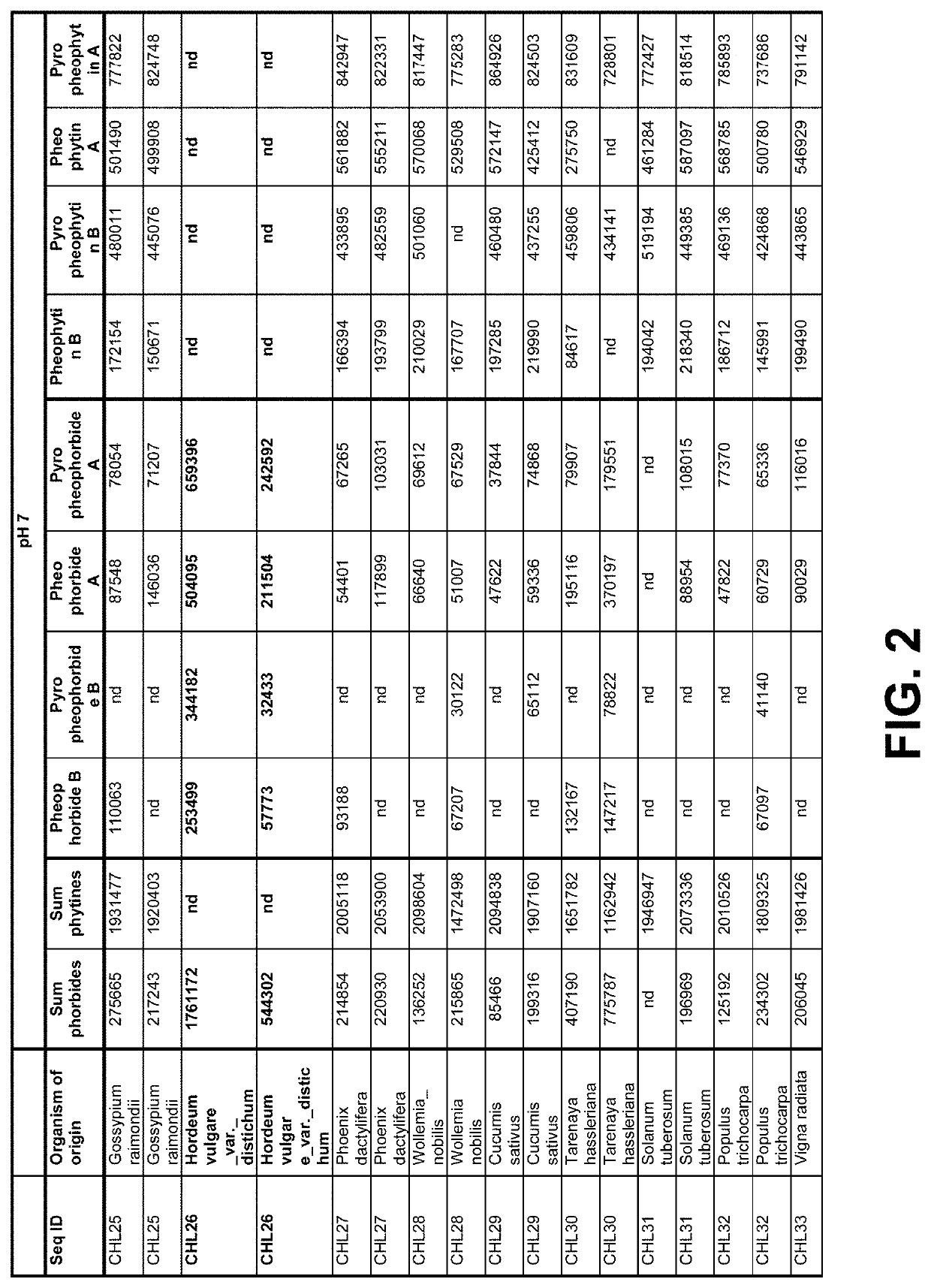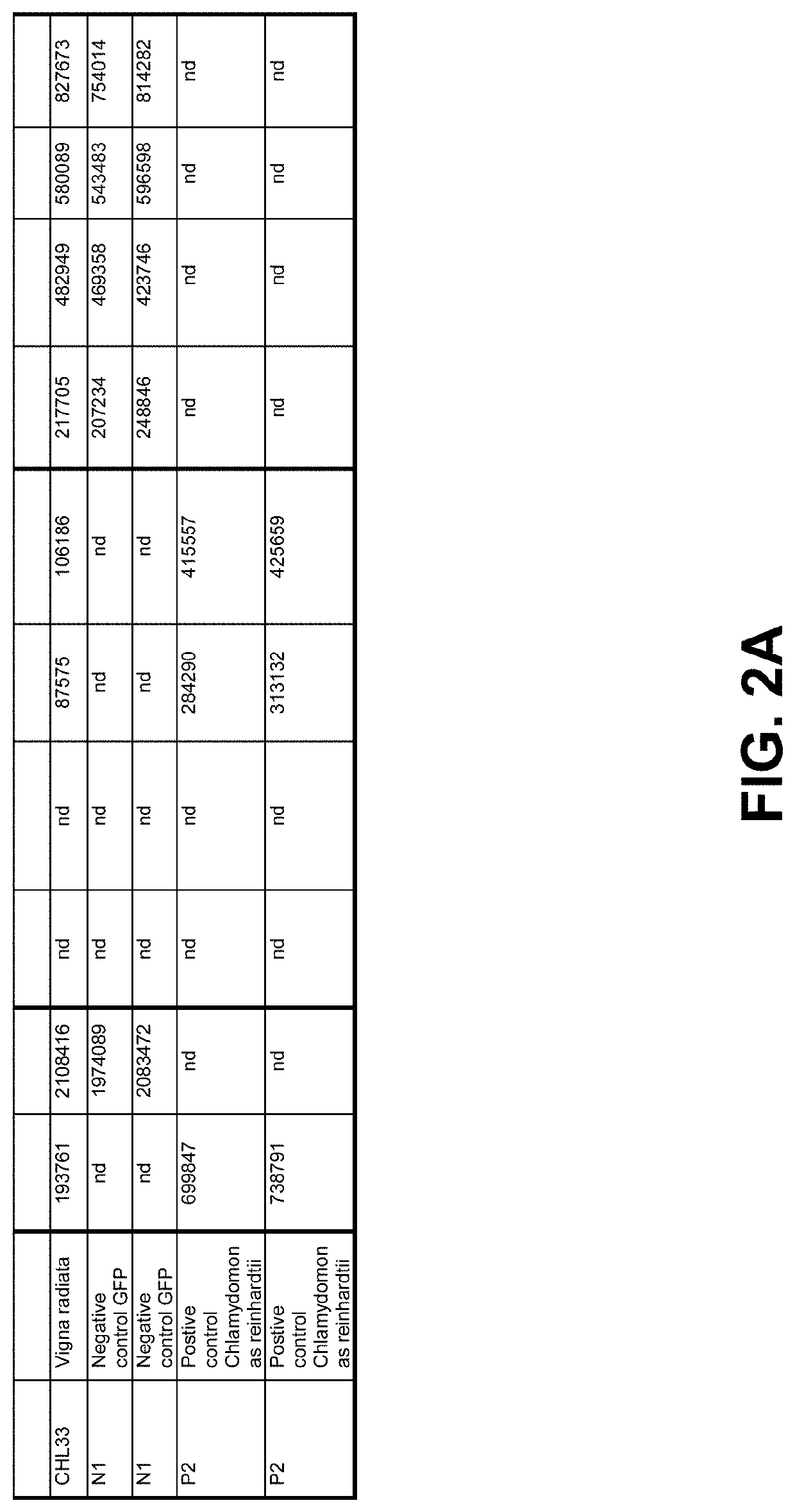Silica adsorbent treatment for removal of chlorophyll derivatives from triacylglycerol-based oils
- Summary
- Abstract
- Description
- Claims
- Application Information
AI Technical Summary
Benefits of technology
Problems solved by technology
Method used
Image
Examples
example 2
tion of Pyropheophytinase Activity in Cell-Free Extracts in Crude Canola Oil Incubation
[0204]Crude canola oil from North American origin, high in pheophytins and pyropheophytins was used to determine activity of the enzyme in the supernatant as produced in Example 1 on pyropheophytin A and B in the following way. Buffer (5% (v / v)) was added to oil under high-shear mixing using a Silverson mixer. For pH 5, a 20 mM citric acid buffer was used. For pH 7 a 20 mM phosphate buffer was used. A 24 wells microtiter plate was filled with 1.425 mL buffer-in-oil dispersion per well, and to each well 75 μL, 5% (v / v) cell-free extract (supernatant) produced in Example 1 was added. A list of tested samples is given in the tables of FIG. 2-2A and FIG. 3, and include a positive reference containing Chiamydomonas reinhardtii pyropheophytinase and negative control Green Fluorescent Protein (GFP). The microtiter plate was covered with plastic foil [Fasson S695]. Each well was stirred with an individual...
example 3
n of Crude Canola Oil with CHL26 Versus Time
[0206]Incubation of crude canola oil with 5% cell free extract of Hordeum vulgare putative chlorophyllase CHL26 produced as described in Example 1, was repeated in the same way as described in Example 2 at pH7. Samples were taken after 30 min, 2 hr, 5 hr, and 24 hr. Pyropheophytin a and b, and pheophytin a and b, pyropheophorbide a and b and pheophorbide a and b were measured by HPLC as described above.
[0207]The formation of the reaction products pyropheophorbide a and b and pheophorbide a and b in Table 1 is expressed as percentage of the amount reaction product (respective phorbide molecule) after 24 hr.
[0208]Table 2 shows the relative amounts of pheophytins and pyropheophytins as a function of time after 0.5, 2 and 5 hr, expressed in percentages relatively to the value at t=0 (average of 4 measurements).
TABLE 1Relative HPLC results for all reaction products afterincubation for 0.5, 2, 5 and 24 hours at pH 7 and 50°C., in percentages rel...
example 4
n of CHL26 and ELDC94 by 10 L Bioreactor Fermentation
[0210]Strains and Inoculum
[0211]Of a P. fluorescens strain containing CHL26 (SEQ ID NO: 1) and Chlamydomonas reinhardtii (ELDC94; SEQ ID NO: 12) chlorophyllase as described in Example 1 a pre-culture was prepared in one-phase shake flasks with complex medium comprising yeast extract, slats and glycerol as a C-source, which was used as inoculum for the 10 L fermentations with inoculation ratio of 10% described below.
[0212]10 L Fermentations
[0213]Fermentation process was based on industrial Pseudomonas fluorescens fermentations (fed-batch process, sugar limited, IPTG induced). The fermentation process consisted of biomass production under exponential feed of glucose as C-source followed by production phase under IPTG induction system. After 23 hr fermentation (end of biomass production phase), IPTG was added to a final concentration of 0.125 mM in order to induce enzyme production. The feed rate of C-source (glucose) was reduced to ...
PUM
| Property | Measurement | Unit |
|---|---|---|
| Temperature | aaaaa | aaaaa |
| Temperature | aaaaa | aaaaa |
| Temperature | aaaaa | aaaaa |
Abstract
Description
Claims
Application Information
 Login to View More
Login to View More - R&D
- Intellectual Property
- Life Sciences
- Materials
- Tech Scout
- Unparalleled Data Quality
- Higher Quality Content
- 60% Fewer Hallucinations
Browse by: Latest US Patents, China's latest patents, Technical Efficacy Thesaurus, Application Domain, Technology Topic, Popular Technical Reports.
© 2025 PatSnap. All rights reserved.Legal|Privacy policy|Modern Slavery Act Transparency Statement|Sitemap|About US| Contact US: help@patsnap.com



